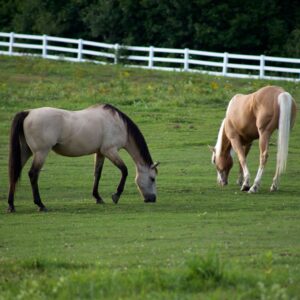 Feed Management Should Mimic Nature: By understanding the horse’s instinctive feeding behavior, today’s feeding strategies can be shaped to mimic natural tendencies. Certain feeding behaviors in horses are triggered by physiological changes and signals. Hormones, nerve signals, and homeostatic mechanisms lead to feelings of hunger. That hunger urges the horse to move around and look for something to eat. In a natural setting, the horse would wander about, lower its head, and graze while smelling and tasting various forages.
Feed Management Should Mimic Nature: By understanding the horse’s instinctive feeding behavior, today’s feeding strategies can be shaped to mimic natural tendencies. Certain feeding behaviors in horses are triggered by physiological changes and signals. Hormones, nerve signals, and homeostatic mechanisms lead to feelings of hunger. That hunger urges the horse to move around and look for something to eat. In a natural setting, the horse would wander about, lower its head, and graze while smelling and tasting various forages.
Chemistry:
Chemicals such as ghrelin, an appetite stimulant, and neuropeptin Y, which encourages grazing and feeding behavior, are produced in response to digestive physiology factors such as level of gut fill. Also, dopamine receptors and other reward mechanisms in the brain become habituated to patterns of behavior like grazing in the company of other horses. This is why owners may notice restlessness in equines that are accustomed to turnout and are then brought into stalls for long periods of time.
Environmental Effects:
Free-ranging horses rarely go more than two to three hours between feeding bouts. They spend an average of 10 to 14 hours per day in grazing behavior. Chewing is nearly continuous while horses are eating grass and other forage. In contrast, stalled horses often gobble their grain meals. In addition, they finish hay rations quickly, and spend many hours with nothing to chew. Mixing chopped forage into grain meals gives horses more opportunity to chew. However, it may also lead to overfilling of the stomach because of a larger amount of material being eaten in a short time.
Behaviors such as stall walking, weaving, cribbing, and eating manure or bedding are directly related to horses attempting to express natural behavior. There is some evidence that horses self-supplement. For example, by eating bedding or manure in order to bring their eating/chewing time up to around ten hours a day.
Hay:
Pasture turnout with other horses most closely mimics natural conditions. If this management is not possible, horses should be kept within sight of other equines. They should be fed small, frequent grain meals instead of one large grain portion. Allow them to nibble hay more or less continuously. For many horses, low-carbohydrate hay may be more suitable than very rich hay. That way, horses don’t consume too many calories.
Hay fed to horses should always be clean and free of mold. Water should be provided free-choice.
Resources:
In conclusion, do you have questions about how Feed Management Should Mimic Nature? Contact us at J & J Hay Farms by clicking here!
Article Sources: Kentucky Equine Research
